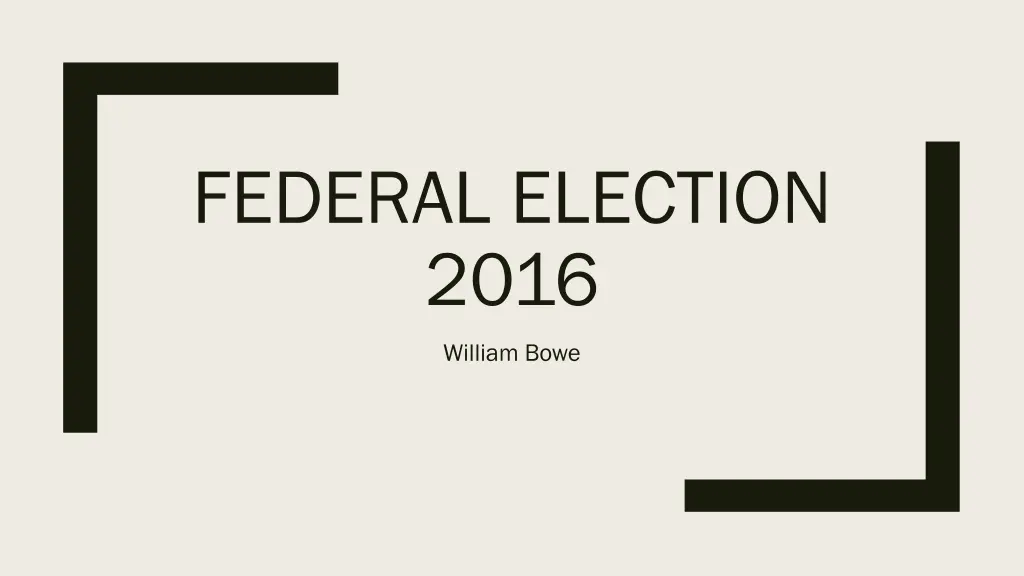
Federal Election 2016 Results Analysis - Swing Predictors and Geographic Patterns
Explore the demographic and geographic predictors of swing to Labor in the 2016 federal election, highlighting the impact of factors such as median age, household income, and high school completion. Discover the pattern of swing in metropolitan Perth and examples of electoral outcomes in various regions across Australia.
Download Presentation

Please find below an Image/Link to download the presentation.
The content on the website is provided AS IS for your information and personal use only. It may not be sold, licensed, or shared on other websites without obtaining consent from the author. If you encounter any issues during the download, it is possible that the publisher has removed the file from their server.
You are allowed to download the files provided on this website for personal or commercial use, subject to the condition that they are used lawfully. All files are the property of their respective owners.
The content on the website is provided AS IS for your information and personal use only. It may not be sold, licensed, or shared on other websites without obtaining consent from the author.
E N D
Presentation Transcript
FEDERAL ELECTION 2016 William Bowe
Demographic predictors of swing to Labor Results indicate Coalition performance relative to 2013 so read as a Turnbull vs Abbott measure Every 10 years of median age lifted Coalition 2PP by 1% Every $1000 of weekly household income lifted Coalition by 0.3% Every percentage point of high school completion lifted Coalition by 0.1% No discernible consistent effect for ethnicity
Geographic predictors of swing to Labor Sydney and Perth swung with roughly equal strength The Coalition performed a lot better in Victoria (in swing terms) Also a fairly strong Coalition performance in Brisbane, despite loss of Longman But in regional Queensland, votes were lost to One Nation and not always recovered as preferences Yet another electoral convulsion in Tasmania
Pattern of swing in metropolitan Perth Swings to Liberal on riverfront and western suburbs Strongest swings to Labor in low- income suburbs in south and south- east Cowan swing tempered by more moderate swings in higher-income suburbs in the west Perfect storm in Burt produced election s biggest two-party swing
Examples of the pattern elsewhere The Liberals were crucially able to retain challenging seats in inner Sydney (Banks and Reid) and Brisbane (Brisbane, Bonner, Petrie) Unexpectedly heavy losses in urban fringe seats in Sydney (Lindsay, Macarthur, Macquarie) and Brisbane (Longman) One seat gained from Labor in Victoria (Chisholm), where Labor had not suffered as badly in 2010 and 2013 and was burdened by state issues Change of state government and low-income effect drove Labor recovery in Tasmania Patchy results in mainland regions: good results for Coalition in Capricornia and Page, but poor ones in Herbert and Eden-Monaro
The levelling of Greens support Are the Greens riding a demographic wave to major party status, or does their support have a ceiling? Long-term analysis of poll trends by Luke Mansillo, supported by this election result, suggests the latter While the Greens have a durable left-of- centre market niche, there are limits on its capacity to benefit from the rise of anti-elite sentiment However, the weakening of party loyalty can present them with opportunities in lower house seats under the right circumstances
Greens target seats in Victoria Melbourne Melbourne Melbourne Ports Melbourne Ports 2016 2016 Swing Vic. 2pp 2pp Swing Vic. 2016 2016 Swing Vic. 2pp 2pp Swing Liberal Liberal 41.9% 41.9% +0.8% -0.9% 51.4% 51.4% +2.2% -1.8% Greens Greens 43.7% 43.7% +1.1% +2.3% 56.1% 56.1% +0.8% Labor Labor 27.0% 27.0% -4.7% +0.8% 48.6% 48.6% -2.2% +1.8% Labor Labor 24.5% 24.5% -2.1% +0.8% 43.9% 43.9% -0.8% Greens Greens 23.8% 23.8% +3.6% +2.3% Liberal Liberal 25.2% 25.2% +2.4% -0.9% Higgins Higgins Batman Batman Liberal Liberal 52.0% 52.0% -2.4% -0.9% 58.0% 58.0% Labor Labor 35.3% 35.3% -6.0% +0.8% 51.0% 51.0% -9.6% Greens Greens 25.3% 25.3% +8.5% +2.3% 42.0% 42.0% Greens Greens 36.2% 36.2% +9.8% +2.3% 49.0% 49.0% +9.6% Labor Labor 14.9% 14.9% -9.1% +0.8% Liberal Liberal 19.9% 19.9% -2.6% -0.9%
The collapse in support for Social Democratic parties in Europe






















